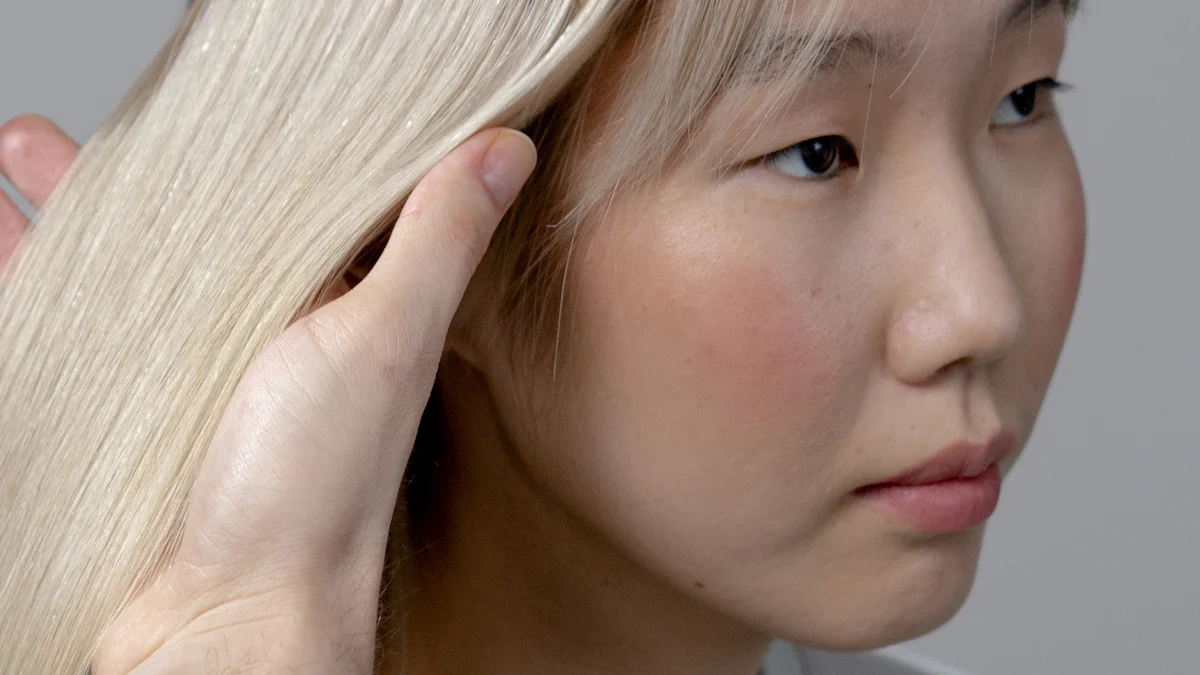What Are the Effects of Clip-In Hair Extensions on Hair Health?

Are hair extensions, particularly clip-in hair extensions like Coovip hair extensions, affecting your hair health? This is a common concern for many individuals who notice changes in their hair. Clip-in hair extensions can be an exciting way to transform your appearance, but they may also raise some issues. You might be concerned about potential hair loss or damage. The clips can exert stress on your natural hair, leading to breakage if not used correctly. Experts frequently caution about traction alopecia, a condition resulting from continuous pressure on hair roots. Therefore, it's essential to understand how these extensions interact with your hair and what steps you can take to minimize any adverse effects.
Do Clip-In Hair Extensions Affect Hair Health?
Clip-In Hair Extensions Concerns
When you think about clip-in hair extensions, you might wonder if they could harm your natural hair. These extensions offer a quick way to add volume and length, but they come with some concerns. One major issue is the potential stress they can place on your hair follicles. If you attach them too tightly or wear them too often, they can weaken your roots. This stress might lead to breakage or even hair loss over time.
Experts from the Intacte Hair Blog highlight that improperly worn clip-in extensions can cause discomfort and potential damage. You should be cautious about placing them too close to your scalp or attaching them too tightly. The tension from the clips can lead to split ends and weakened hair strands. It's crucial to manage them properly to avoid these issues.
Extensions Cause Hair Loss
You might have heard that extensions cause hair loss, and there's some truth to that. When you use clip-in hair extensions frequently, they can exert pressure on your natural hair. This pressure can lead to traction alopecia, a condition where hair loss occurs due to repeated strain on the hair follicles. The USA Hair Blog notes that this tension can result in hair thinning and even traction alopecia if not managed correctly.
However, not all extensions are created equal. High-quality clip-in hair extensions often feature safe clip technology. This technology minimizes the risk of pulling out your hair, as mentioned by the Foxy Locks Blog. So, choosing the right type of extensions and using them correctly can help reduce the risk of hair loss.
Understanding the Risks of Clip-In Extensions
Clip-In Extensions Bad for Hair
You might wonder if clip-in extensions are bad for your hair. The truth is, they can be if not used properly. Experts in hair extensions emphasize that incorrect application can lead to significant discomfort and potential damage. When you place the clips too close to your scalp or attach them too tightly, they can pull on your hair roots. This tension might cause headaches and even scalp irritation. You could experience soreness from improperly positioned extensions, especially if you wear them for long periods.
To avoid these issues, it's crucial to learn proper application techniques. Choose extensions that match your hair's thickness and texture. This way, you can enjoy the benefits without the drawbacks. Remember, the key is to use them wisely and not overdo it.
Traction Alopecia and Hair Loss
Traction alopecia is a real concern when it comes to clip-in hair extensions. This condition occurs when repeated strain on your hair follicles leads to hair loss. The clips exert pressure on your hair and scalp, increasing the risk of damage over time. If you don't manage this tension properly, you might notice breakage and thinning.
Experts warn that the friction caused by the clips can lead to split ends and weakened hair strands. You might even find extensions causing an itchy scalp due to the constant pressure. To prevent traction alopecia, give your hair regular breaks from extensions. Ensure that you apply them correctly and avoid wearing them every day. By taking these precautions, you can minimize the risks and keep your hair healthy.
Mechanisms of Hair Damage

How Clip-Ins Disrupt Natural Hair Growth
You might wonder how clip-in hair extensions can disrupt your natural hair growth. Well, when you attach these extensions, they can exert pressure on your hair follicles. This pressure can lead to weakened roots over time. If you wear them too often or attach them too tightly, you might notice your hair becoming more fragile. The constant pulling and tension can cause your hair to break, especially if it's fine or delicate.
Experts from the Intacte Hair Blog emphasize that clip-in extensions can lead to traction alopecia. This condition occurs when repeated strain on your hair follicles results in hair loss. You might find that your hair doesn't grow as it should because the extensions stop hair growth by causing stress on the scalp. To maintain healthy hair, it's crucial to give your hair regular breaks from extensions and ensure they're applied correctly.
Extensions Damage Your Hair
You may have heard stories about how extensions ruined someone's hair. While this isn't always the case, improper use can indeed lead to damage. Clip-in hair extensions can cause tension on your natural hair, leading to breakage and even traction alopecia. The clips can add weight and pressure, which might result in hair loss if worn daily.
The USA Hair Blog points out that incorrectly worn clip-in extensions can cause significant discomfort and potential damage. You might experience headaches or scalp irritation if the clips are too tight. To prevent this, make sure you choose extensions that match your hair's thickness and texture. Proper application is key to avoiding damage and keeping your hair healthy.
Remember, while clip-in hair extensions offer a quick way to change your look, they require careful handling. By understanding how they interact with your hair, you can enjoy the benefits without the drawbacks. Always prioritize your hair's health and take steps to minimize any potential harm.
Preventing Hair Loss from Clip-In Extensions
Wearing clip-in extensions can be a fun way to change your look, but you need to take steps to protect your natural hair. Here are some practical tips to help you avoid hair loss and keep your hair healthy.
Tips to Avoid Hair Loss
-
Limit Usage: Try not to wear hair extensions every day. Give your hair regular breaks to reduce stress on your hair follicles. This practice helps prevent hair loss and keeps your hair strong.
-
Proper Placement: When attaching clip-in extensions, make sure they are not too tight. Tight clips can pull on your hair and lead to breakage. Place them a little away from the scalp to minimize tension.
-
Choose Quality Extensions: Invest in high-quality clip-in extensions. They are designed to be gentler on your hair. Look for extensions with safe clip technology to reduce the risk of damage.
-
Regular Maintenance: Follow a hair extensions aftercare guide to maintain both your extensions and natural hair. Regularly clean and condition your extensions to keep them in good shape.
-
Consult Professionals: If you're unsure about how to use clip-in extensions, seek advice from hair care professionals. They can provide guidance on proper application and maintenance.
Properly Caring for Extensions
Taking care of your extensions is just as important as taking care of your natural hair. Here's how you can do it:
-
Gentle Handling: Handle your extensions with care. Avoid tugging or pulling when brushing or styling them. Use a wide-tooth comb to detangle gently.
-
Wash with Care: Wash your extensions with sulfate-free shampoo and conditioner. This helps maintain their quality and prevents them from becoming dry or brittle.
-
Store Properly: When not in use, store your extensions in a cool, dry place. Use a storage bag or box to keep them tangle-free and protected from dust.
-
Avoid Heat Damage: Limit the use of heat styling tools on your extensions. If you must use them, apply a heat protectant spray first to minimize damage.
By following these tips, you can enjoy the benefits of clip-in extensions without compromising your hair's health. Remember, the key is to use them wisely and give your hair the care it deserves.
Alternatives to Clip-In Hair Extensions

If you're considering alternatives to clip-in hair extensions, you're in luck. There are several options available that can help you achieve the desired volume and length without the potential drawbacks of clip-ins. Let's explore some of these alternatives and how they might suit your needs.
Types of Hair Extensions
-
Halo Hair Extensions: These extensions are a fantastic choice if you want something easy to apply and remove. They sit on your head like a halo, blending seamlessly with your natural hair. You don't need clips or glue, making them gentle on your scalp. Halo hair extensions are perfect for those who want a quick transformation without the hassle.
-
Seamless Hair Extensions: If you're looking for a more permanent solution, seamless hair extensions might be the way to go. They use a thin, flexible weft that lies flat against your scalp, providing a natural look. These extensions are ideal for those who want to add volume and length without visible clips or bonds.
-
Tape-In Extensions: These extensions involve small sections of hair attached with adhesive tape. They're lightweight and blend well with natural hair. Tape-ins are a great option if you want a semi-permanent solution that lasts several weeks.
-
Foxy Locks Extensions: Known for their high quality, Foxy Locks offers a range of extensions that cater to different needs. Whether you want human hair or synthetic options, Foxy Locks provides durable and stylish solutions.
When choosing the right type of extension, consider your lifestyle and how often you plan to wear them. Each type has its benefits, so compare methods to find the best fit for you.
Natural Methods to Enhance Hair Volume
If you prefer to avoid extensions altogether, there are natural ways to boost your hair's volume:
-
Proper Hair Care: Regularly washing and conditioning your hair can keep it healthy and full. Use volumizing products to add body and lift.
-
Diet and Nutrition: Eating a balanced diet rich in vitamins and minerals can promote hair growth and thickness. Foods like salmon, nuts, and leafy greens are excellent for hair health.
-
Scalp Massages: Gently massaging your scalp can stimulate blood flow and encourage hair growth. Use essential oils like rosemary or peppermint for added benefits.
-
Hairstyling Techniques: Simple tricks like blow-drying your hair upside down or using a round brush can create the illusion of volume. Experiment with different styles to find what works best for you.
By exploring these alternatives, you can enhance your hair's appearance without relying solely on clip-in hair extensions. Whether you choose extensions or natural methods, the key is to find a solution that aligns with your preferences and lifestyle.
Balancing the Benefits and Risks
When considering clip-in hair extensions, it's essential to weigh their advantages against potential drawbacks. Understanding both sides helps you make an informed decision about whether these extensions are right for you.
Advantages of Using Clip-In Extensions
Clip-in hair extensions offer several benefits that make them a popular choice for many. Here are some reasons why you might consider using them:
-
Versatility: Clip-in extensions provide a flexible way to change your hairstyle. Whether you're aiming for a sleek ponytail, voluminous waves, or a chic bun, these extensions allow you to experiment with different looks without a long-term commitment.
-
Ease of Use: Applying clip-in extensions is straightforward. You can easily attach and remove them at home, making them a convenient option for those who want to switch up their style quickly.
-
Minimal Damage: Unlike some permanent extensions, clip-ins are less likely to cause damage to your natural hair when used correctly. They don't require glue or heat, which helps protect your hair's health.
-
Cost-Effectiveness: Clip-in extensions are generally more affordable than other types of extensions. They offer a budget-friendly way to enhance your hair's length and volume.
-
Color Options: With a wide range of colors available, you can find extensions that match your hair color perfectly. Some brands, like Coovip Hair, even offer a virtual color match service to help you find the ideal shade.
Weighing the Potential Drawbacks
While clip-in extensions have many benefits, it's important to be aware of their potential downsides:
-
Temporary Solution: Clip-in extensions are designed for temporary use. If you're looking for a long-term change, you might need to explore other options.
-
Potential for Hair Damage: If not applied correctly, clip-in extensions can cause stress on your hair follicles, leading to breakage or thinning. It's crucial to follow proper application techniques to minimize this risk.
-
Maintenance Requirements: To keep your extensions looking their best, you'll need to invest time in regular maintenance. This includes washing, conditioning, and storing them properly.
-
Color Match Challenges: Finding the perfect color match can be tricky. While services like Coovip Hair's virtual color match can help, there's still a chance that the extensions might not blend seamlessly with your natural hair color.
-
Image Concerns: If not applied correctly, clip-in extensions can appear unnatural. Ensuring a seamless blend with your natural hair is key to achieving a polished look.
By considering both the benefits and risks, you can decide if clip-in extensions align with your hair goals and lifestyle. Whether you're looking for a temporary style boost or a more permanent solution, understanding these factors will guide you in making the best choice for your hair.
Clip-in hair extensions offer a versatile and temporary way to enhance your hair's volume and length. They can transform your look with ease, but it's crucial to weigh the benefits against potential drawbacks. Proper care and usage are key to minimizing issues like tangling or discomfort. Always consider the color match to ensure a seamless blend with your natural hair. By understanding both the pros and cons, you can make an informed decision that suits your individual needs. Remember, maintaining your hair's health should always be a priority when using extensions.










